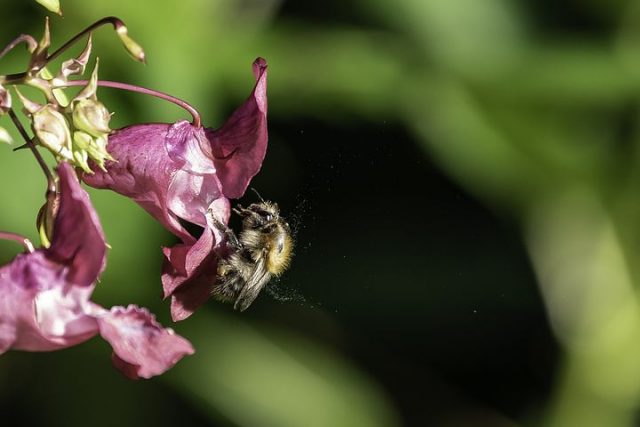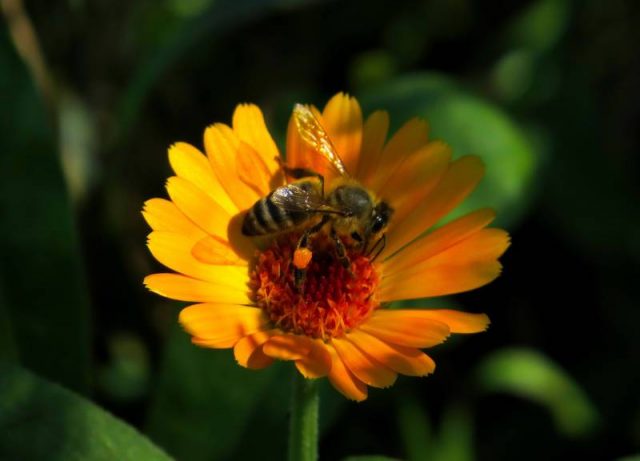Content
Collecting pollen by bees is an important process both in the operation of the hive and in the beekeeping industry. Bees transfer pollen from one honey plant to another and pollinate plants. Nutrient mixtures and other components of the hive are created from the shredding. Therefore, any beekeeper should know how the collection takes place, whose duties in the hive include it and how the insects process pollen. If the product in the hive is not enough for the winter, then the bee colony may die or be severely weakened by spring.
What role does pollen play in the life of bees?
Pollen is the male reproductive cells of plants. Bees collect pollen for feeding their offspring, as well as for other needs. Pollinators, after collecting pollen, make bee bread - bee bread. Perga is folded into honeycomb cells, which, after filling, are sealed with wax. These are supplies for the long, cold winter. One bee colony can collect up to 2 kg of pollen per day. For several weeks of flowering, insects collect pollen and make bee bread much more than they need to feed in winter. This is due to the instinct that makes insects constantly work for the good of the hive.
For a year, a bee colony consumes much less pollen than it collects. This is due to a powerful instinct that makes the worker fly, regardless of the fullness of the hives.
The second reason for constant work is that beekeepers remove excess product, and insects must be ready for winter. If the beekeeper does not calculate his strength and selects more product from the hive than is allowed, the bee colony runs the risk of surviving the winter with great losses.
Which bees collect pollen
All responsibilities are strictly distributed in the bee family. Only the drones do not collect pollen and nectar. Their task is to fertilize eggs. All other family members work to raise offspring and maintain order in the hive, as well as to stock up for the winter. First of all, scouts fly out of the hive, who are looking for honey plants and then, using a specific dance, inform the rest of the inhabitants of the hive about this place. If the worker bees have finished collecting pollen or they do not like the honey plants offered by the scout, then she flies out in search of new places to feed.
Then collectors come forward. These are working pollinators who collect the pollen itself. This variety of working insects is also called field insects, since they do not work in the hive, but in the fields with honey plants. Upon arrival at the hive, they hand over the material to the receivers. These types of bees are involved in the processing of pollen.
What bees collect: nectar or pollen
Bees collect both nectar and pollen. But the purpose of such prey is different. The nectar is collected in a special bag under the abdomen and used as food for the bee itself. All flowering plants contain nectar. The bees immerse their tongue there, which is rolled into a tube and located in the proboscis, and collects nectar. One bag can hold up to 70 mg of the substance. When the toiler returns to the hive, the product receivers suck the prey out of her goiter. Honey is obtained from nectar in a special way after a long process.Honey pollen is collected using a different technology.
Where do bees collect pollen?
There is no special bag for collecting pollen on the body of the insect. Therefore, they collect pollen from the whole body, or rather, its villi. The pollen of plants collected by the bee is folded into a basket on its hind legs. It turns out a ball, which, depending on the honey plant, has different shades: from yellow to black. Field bees spend up to two hours of their time a day collecting pollen.
Only bad weather can stop the collection of peg and nectar. At this time, pollinators are in the hives.
Pollen collection
The process of collecting pollen itself consists of several stages:
- A bee, with the help of a scout, seeks out fragrant and attractive honey plants.
- Sitting on the selected flower, the insect collects pollen on all the villi.
- The product is collected on legs, body, wings.
- The insect gently combes its hair with its paws, collecting prey from all the villi.
- Then he forms a ball and lowers it into the basket on the shins of the hind legs.
To create one balloon, you need to fly around a thousand flowers. Then, with her prey, the toiler flies into the hive. Here she dumps pollen into the cells. This is done using special spurs that are located on the middle legs. Further, the processing of the polish takes place.
Dumping and recycling of peg
After dropping the pollen into the cells that are closer to the brood, the bees begin to process it. This is the work of insects that do not fly out of the hive. Young insects are engaged in pollen processing.
- Loose lumps of polish with jaws.
- Moistened with nectar and saliva glands.
- Tamped with heads.
- Pour the fermented pollen with honey.
- Seal with wax.
In this form, the polish remains for six months or even more. When the pollen is tightly packed, lactic acid fermentation processes take place in it. Lactic acid, which is produced as a result of this process, is a natural preservative and protects the bee bread from deterioration.
Throughout spring and summer, pollinators collect and store pollen so that there is enough food for a safe wintering and for feeding the brood. If less than 18 kg of pollen is collected in a year, then the bee colony will be on the verge of death and may not survive the winter.
How bees transfer pollen from flower to flower
In order to collect 20 mg of pollen, the insect flies around a thousand honey plants. In this case, the bees pollinate the flowers. Pollen is male germ cells. If the plants are monoecious, then for fertilization the male cells must be delivered to the female flowers.
When collecting nectar and pollen, the insect flies from flower to flower. Part of the collected pollen from the villi of the insect remains in the flower. This is how the pollination of plants by bees occurs. By this, insects play a huge role in the reproduction of honey plants. Most wild and cultivated plants need pollination by bees.
What bees pollinate
Among the honey plants there are hundreds of different flowers, shrubs and trees. Bees pollinate:
- many shrubs: hawthorn, currant, raspberry, wild rosemary, heather, barberry, gooseberry;
- fruit and common trees: apricot, apple, pear, acacia, cherry, oak, chestnut, maple, bird cherry, birch, plum, linden;
- herbaceous plants: clover, watermelon, cornflower, coltsfoot, thyme, lungwort, basil, alfalfa, ivan tea.
Many vegetables in the garden and greenhouses are also pollinated by insects. These include: cucumbers, onions, pumpkin, some varieties of tomatoes, peppers and eggplants.
How to attract bees to your greenhouse for pollination
It is important to attract bees to the greenhouse if there are crops that need cross-pollination there. There are some tips to lure bees into your greenhouse:
- plant flowers in a greenhouse;
- provide unhindered access for bees to collect pollen;
- put an apiary near the greenhouse;
- use various baits;
- completely neutralize foreign odors.
You can attract bees to the greenhouse with a whole range of such measures. First of all, it is important that insects have access to the inside of the greenhouse. To do this, the greenhouse is equipped with the maximum number of doors and vents, which are opened in hot weather suitable for pollination.
It is also recommended to plant sunflower, jasmine or petunias in the greenhouse as attractive plants.
It is great if there is an apiary next to the greenhouse.
The following substances are used as baits:
- sugar syrup with the aroma of the necessary flowers, in which case pollinators will fly exactly to this smell;
- make feeders for bees with sugar syrup and transfer them to the greenhouse;
- use aromatic oils to attract insects: mint or anise.
When using feeders, it is not necessary to keep them in a greenhouse constantly, you can take them out for a while. But it is not recommended to carry the feeders further than 700 m from the greenhouse.
How to attract bees to cucumbers
It is not difficult to attract bees to pollinate cucumbers. The vegetable can grow both in the greenhouse and in the open field. You can attract bees to the greenhouse to collect nectar if you spray all the cucumbers with a special solution. The recipe is simple:
Mix 1 liter of room temperature water with a large spoonful of jam or honey. Add 0.1 g of boric acid. After spraying, the bees will fly to the scent and pollinate the cucumbers in the home greenhouse.
In early spring, a colony of bees can be placed in a greenhouse with cucumbers. To do this, it is necessary to place the hive on the side rail of the greenhouse at a height of 40 cm. In this case, in a glass greenhouse, it is recommended to darken the windows behind the hive with a cloth or a sheet of cardboard or plywood.
Conclusion
Bees carry pollen from flower to flower. This is how cross-pollination occurs. Through this process, you can get a large harvest both in the garden and in the vegetable garden. At the same time, gardeners have to solve the problem of how to attract pollinating insects to the greenhouse. There are several ways, but in any case, it is important that the bee colony lives no further than 2 km from the home greenhouse. Otherwise, the insects simply will not reach.












